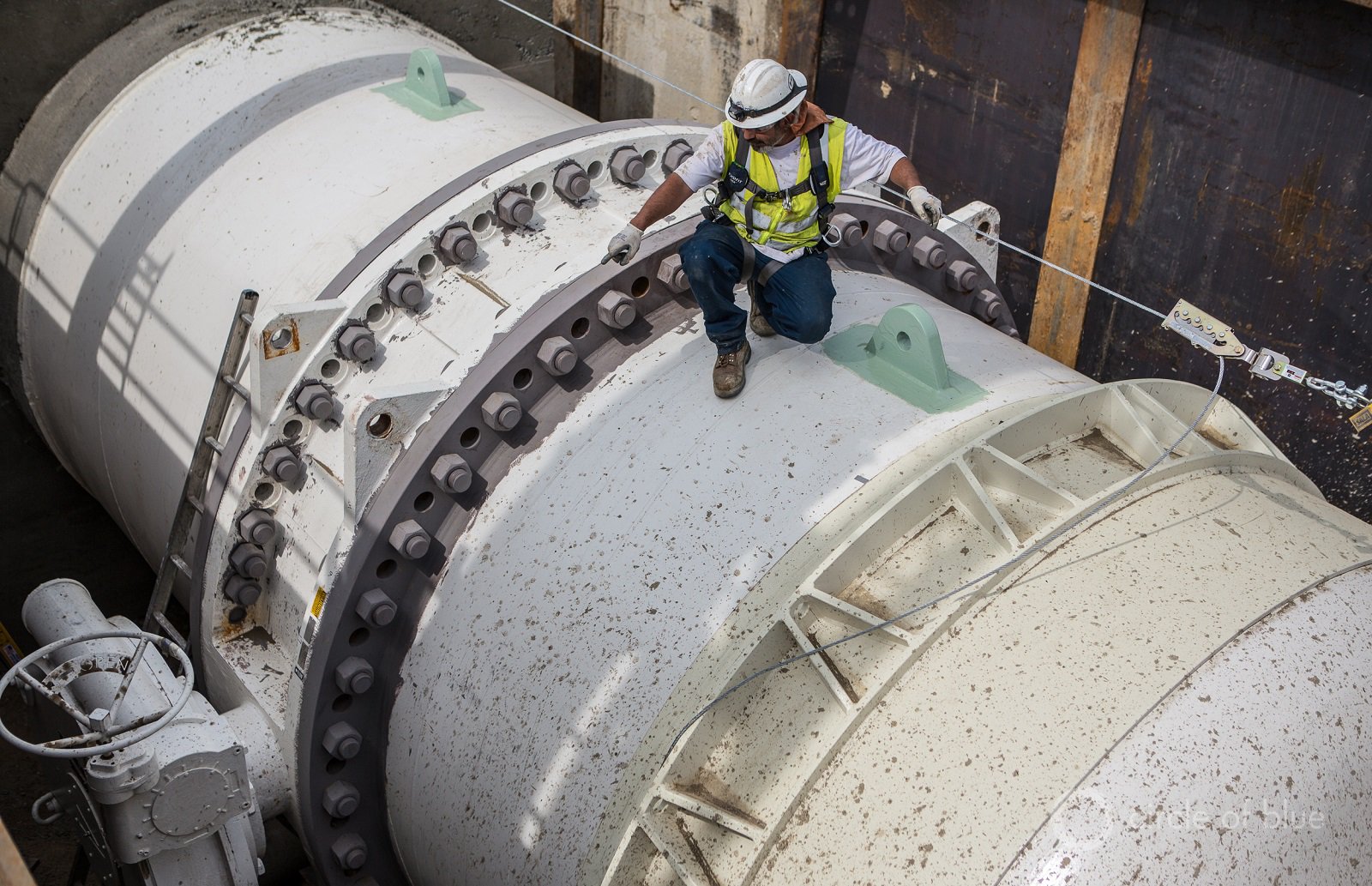2018 Preview: What Not to Ignore About Water Infrastructure
Communities need to invest in and maintain water systems.

Los Angeles Department of Water and Power workers install a 144-inch pipe that will connect to an ultraviolet treatment plant. Photo © J. Carl Ganter / Circle of Blue
By Brett Walton, Circle of Blue
Infrastructure was supposed to be an arena of bipartisan comity in Donald Trump’s first year as president. Instead, it became an afterthought as the administration tussled with Congress over health care, border security, and tax cuts while jettisoning waves of advisers and staff.
Having signed the tax bill just before Christmas, Trump promised to offer a public works plan in the new year. Large sums of money are potentially in play — a $1 trillion figure has been discussed by both Democrats and Republicans for repairing, modernizing, and extending the nation’s water pipes, roads, airports, dams, transmission lines, bridges, and sewer systems.
Nearly everyone agrees that significant investment is necessary, especially as a warming planet renders old design assumptions obsolete. Perpetually low performance grades, just above failing, from the American Society of Civil Engineers attest to serious deficiencies in the nation’s connective hardware. But simply building more stuff, infrastructure experts argue, can set up communities for long-term financial failure. Maintenance, they say, should be a bigger part of the infrastructure equation.
Changing Direction
Chatter from the White House in the administration’s early months suggested a large role for investor-owned companies. The pedigrees of the main actors hinted at that course as well. Mike Pence, the vice president, was the governor of Indiana, a test bed for private-sector leasing of toll roads. D.J. Gribbin, special assistant to the president for infrastructure policy, is an alumnus of Macquarie Capital, where he shepherded public-private infrastructure deals.
But recently the administration seems to have changed course. At a Hudson Institute conference on December 12, Gribbin indicated that federal funding would be contingent on local and state government contributions. Many federal grants require a local dollar match, but the ratio for the president’s plan has not been determined.
“Part of what we want to do with our incentive program is to say, ‘Listen, if you as a state or local elected official are willing to create a new revenue stream for infrastructure, we as the federal government want to partner with you on that,’” Gribbin explained.
Raising revenues might work well for cities because of their larger populations, Gribbin said. But it will be harder for rural areas, which, he said, will receive block grants from federal coffers. A recent RAND Corporation study reinforces the argument that well-managed urban areas are in rude financial health, an economic plenty that extends to water spending. San Francisco, for instance, is nearing completion of a $4.8 billion overhaul of its distribution system. But in communities with shrinking tax revenues, problems “defy easy solutions,” the report notes.
Whatever the eventual source of funds, a number of water infrastructure analysts are concerned about how the money is spent. They argue that many cities and small towns have overextended themselves, and are being overwhelmed by the cost of maintaining their systems. Some systems already feel maxed out — local and state funds account for about 95 percent of water infrastructure spending.
“Many funding programs are designed to build projects, but in some cases these new projects lead to other challenges down the road,” Jeff Hughes, director of the University of North Carolina Environmental Finance Center, wrote to Circle of Blue in an email. He predicted that some projects, especially in rural areas, that are supported by state or federal funds today may not be financially viable in two decades because of declining populations.
Grandiose projects that are a burden to maintain are known as white elephants. Experts worry that a herd of smaller projects can do similar damage. The accumulation of maintenance burdens — for roads, water pipes, treatment plants, and others — can slowly cripple a shrinking town.
“We have created a lot of short-term growth, but we’ve also created trillions of dollars of non-performing assets — infrastructure investments that are slowly bankrupting our cities, towns, and neighborhoods,” Charles Marohn, president of Strong Towns, an urban planning group, wrote in December in an open letter to the president.
California is perhaps the only state to consider funding the operation and maintenance of water systems in poor communities. Last year they proposed levying a tax on fertilizer sales and a fee of $0.95 per month on residential water bills and using the funds to help cover system repairs. The bill, SB 623, did not have the votes to pass but lawmakers will try again in 2018.
California is a rare example, though. Hughes was not aware of any similar proposals in the U.S. for providing operations and maintenance assistance.
For any project requiring a payback period 20 or 30 years into the future, Hughes strongly suggests requiring a demographic analysis that includes multiple scenarios. Is the town’s population declining? How will that decrease affect water rates? Will rate increases make water unaffordable for remaining customers and dissuade newcomers from connecting to the system?
Hughes said he’s seen these dynamics play out in several counties in North Carolina where projects that penciled out a decade ago now have financial situations in which “the numbers look distressing.” The projects no longer seem financially viable because town populations are greying and declining.
If rate revenue is not sufficient, there are several options. Communities may look to general funds from sales or property taxes to close any gaps.
Small communities could also merge their systems into a single entity with a larger customer base. Kentucky has been a leader in these consolidations, and California lawmakers gave state regulators the authority, in 2015, to force larger systems to absorb a poorly managed neighbor. A bill introduced in the U.S. House of Representatives would give the same authority to the Environmental Protection Agency. Water policy researchers expect system consolidations to draw more attention in 2018 and into the future.
Trump, who uses his real estate background to fashion himself as a “builder,” has addressed infrastructure with typical bluster. “Infrastructure is the easiest of all,” he said on December 22 after signing the tax bill. That might be true for laying a pipe. The trick is to keep the water flowing years down the road.
Brett writes about agriculture, energy, infrastructure, and the politics and economics of water in the United States. He also writes the Federal Water Tap, Circle of Blue’s weekly digest of U.S. government water news. He is the winner of two Society of Environmental Journalists reporting awards, one of the top honors in American environmental journalism: first place for explanatory reporting for a series on septic system pollution in the United States(2016) and third place for beat reporting in a small market (2014). He received the Sierra Club’s Distinguished Service Award in 2018. Brett lives in Seattle, where he hikes the mountains and bakes pies. Contact Brett Walton








